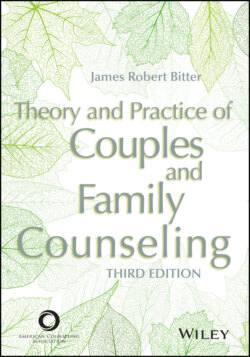Читать книгу Theory and Practice of Couples and Family Counseling - James Robert Bitter - Страница 9
Оглавление
FOREWORD
In the 1960’s I went through my entire doctoral program thinking the best way to study counseling was to understand the dynamics of the individual. My friend and colleague, Dr. Jim Bitter, was one of the key people to introduce me to a couples, family, and systemic approach to counseling and psychotherapy. Being exposed to a systemic perspective broadened my view of individual counseling and working with individuals in group counseling. I appreciate his emphasis on knowing the role of an individual’s family of origin if we hope to effectively counsel a person.
Dr. Bitter has given workshops in Canada, England, Greece, Ireland, South Korea, New Zealand, and Peru as well as throughout the United States. He is an exceptionally gifted therapist who is a master at doing live presentations. He demonstrates respect, curiosity, interest, compassion, and a deep understanding of individuals in a family in his workshops. His presence encourages the family he is working with to reveal themselves in significant ways, and genuine encounters occur. His style as a person and as a practitioner is evident in this book. He draws from his practical experience to give this book an applied slant. This textbook is written in a scholarly manner, yet it is also personal and conversational. The theories come to life, and you are likely to have a sense that you are not just seeing them presented in a textbook but observing them being demonstrated. You are invited to reflect on your own family-of-origin experiences as you read each theory. In this way, reading and reflecting on the chapters is somewhat akin to having a therapeutic experience.
In this third edition of Theory and Practice of Couples and Family Counseling, several new topics and theories are introduced. New to this edition are
a focus on couples counseling (three new chapters and sections in each of the earlier family chapters);
an emphasis on wellness and resiliency;
an expanded history of the profession; and
the case example of the Quest family, a part of each of the theory chapters, which involves a blended family with two children from a different culture.
A number of features make this book unique among couples and family counseling textbooks. Dr. Bitter uses a common format to organize each of the theory chapters, which will make your job of comparing these approaches easier. The first four chapters give you a fine introduction to the field and to the rest of the book; in two of these chapters, you get a real sense of Jim Bitter the person, the author, the teacher, and the couples and family counselor. Each of the theory chapters has exceptionally clear sections on key concepts, goals, and techniques. You will be introduced to the Quest family and then follow this family for each of the theory chapters. This case example gives a concrete illustration of how each theory can be applied to counseling the same family. The personal exercises that appear at the end of each chapter will assist you in personalizing your learning and help you apply what you are reading to gain a fuller understanding of how your family background influences you personally and professionally. The chapter on integrative approaches aims to assist you in thinking about your own personal synthesis. Dr. Bitter does an excellent job of guiding you through the process of learning how to focus on aspects of various theories that fit the person you are.
I found the summary sections to be very helpful in pulling together the key ideas of each chapter; furthermore, the sections on multicultural and gender concerns are most useful for seeing practical applications. You will find numerous suggestions for where to go beyond the chapter if you want to learn more about any theory. This text will challenge you to think and to reflect on what you are reading. I trust that you will feel encouraged in your own quest to better understand how your family history impacts you and your journey to becoming a relational practitioner. I have read this book several times, and it has been instrumental in helping me gain a deeper understanding of family counseling. My hope is that you too will be enlightened and encouraged to do what it takes to become an effective relational practitioner—and that this book will be a part of that experience.
Although other family therapy textbooks are available, in my view Theory and Practice of Couples and Family Counseling is the most personal and well written, and it is my choice for a text for a family therapy course.
—Gerald Corey, EdD, ABPP Professor Emeritus, Human Services and Counseling California State University, Fullerton
